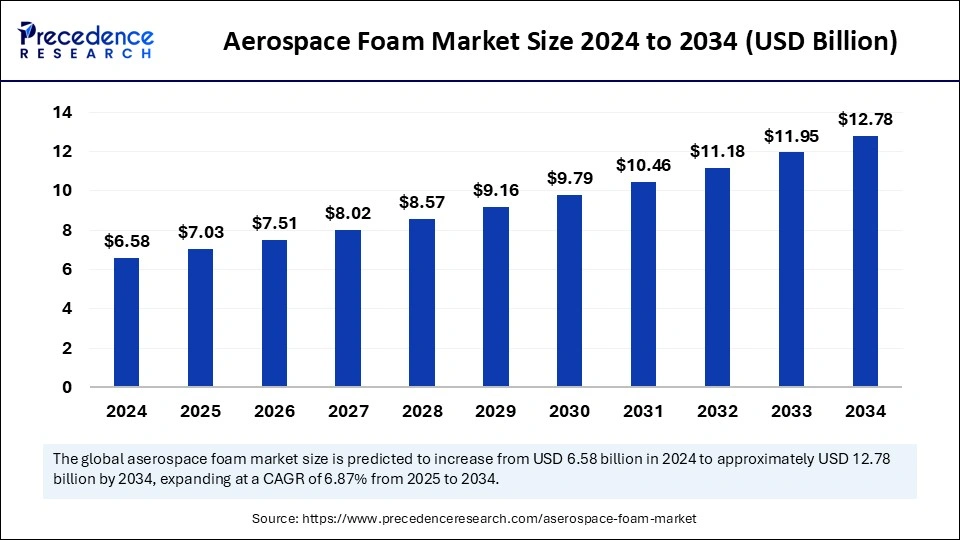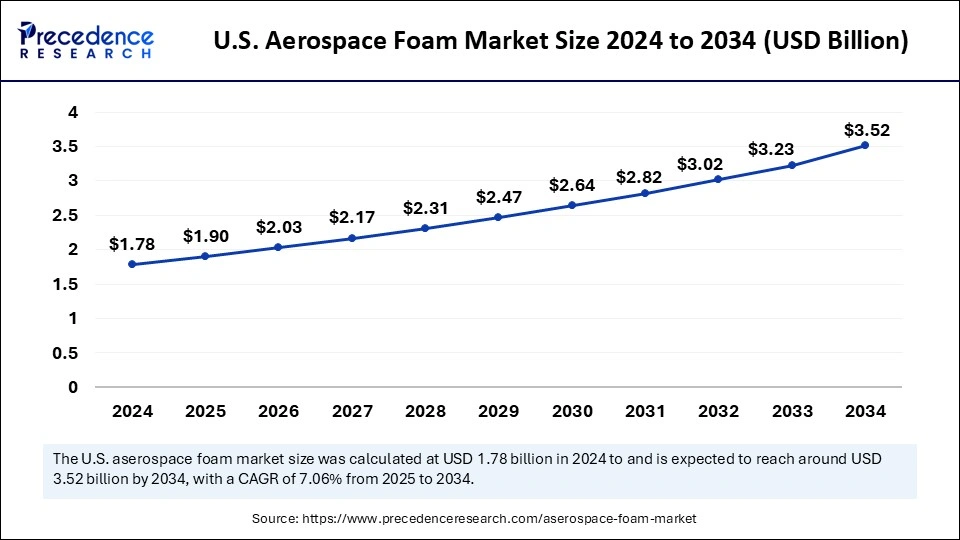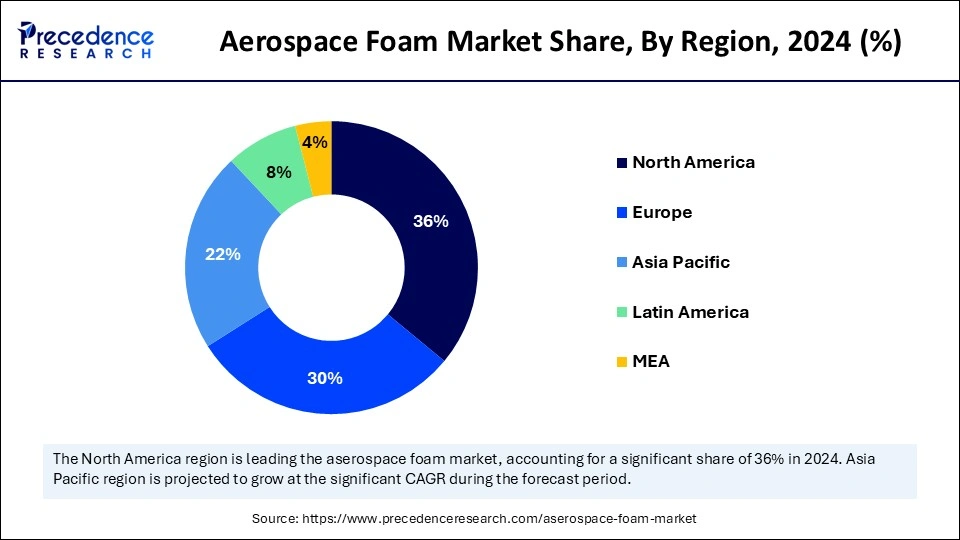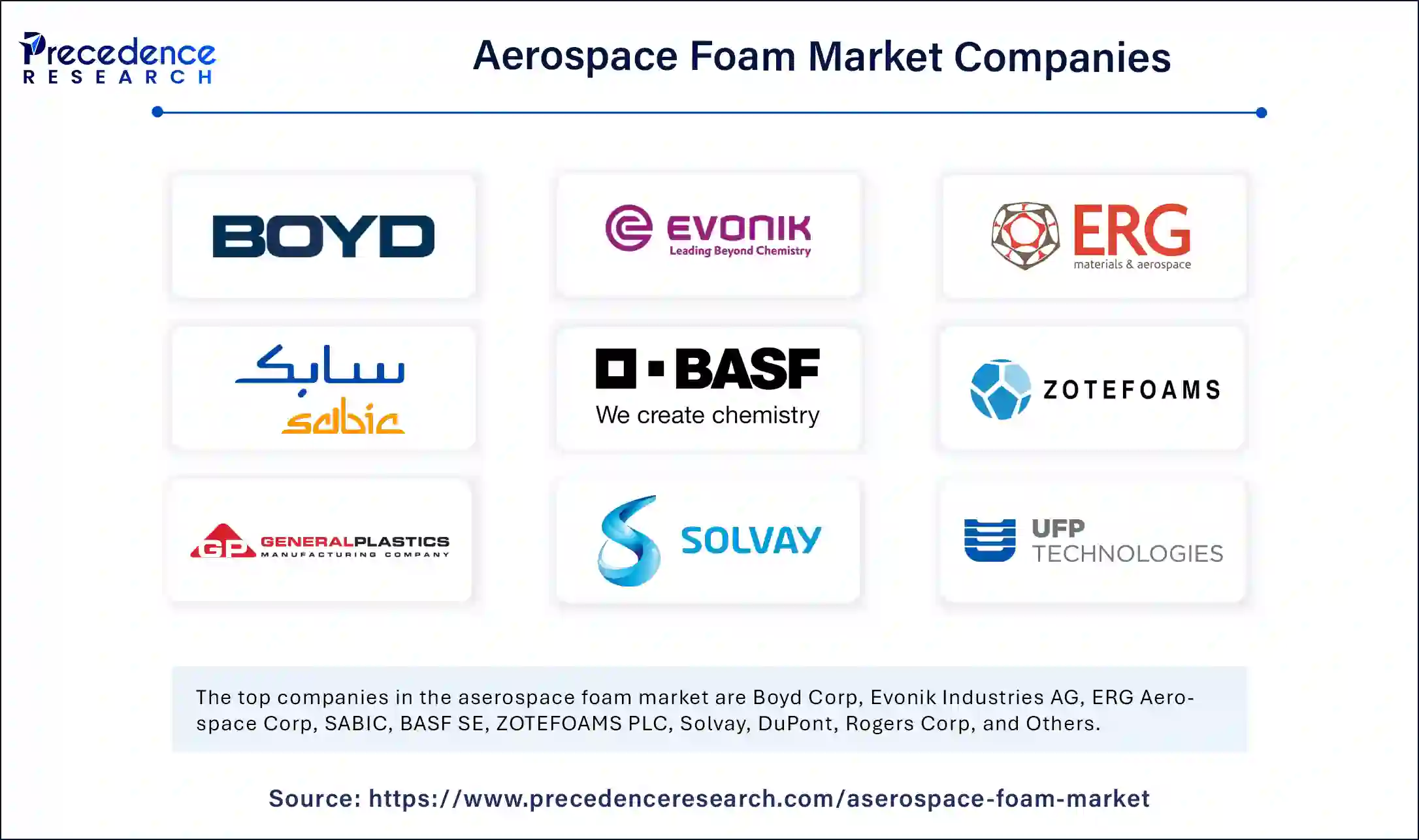October 2024
The global aerospace foam market size is calculated at USD 7.03 billion in 2025 and is forecasted to reach around USD 12.78 billion by 2034, accelerating at a CAGR of 6.87% from 2025 to 2034. The North America market size surpassed USD 2.37 billion in 2024 and is expanding at a CAGR of 7.00% during the forecast period. The market sizing and forecasts are revenue-based (USD Million/Billion), with 2024 as the base year.
The global aerospace foam market size accounted for USD 6.58 billion in 2024 and is predicted to increase from USD 7.03 billion in 2025 to approximately USD 12.78 billion by 2034, expanding at a CAGR of 6.87% from 2025 to 2034. The market grows, driven by the requirement for lightweight aircraft design and advanced sustainable materials to support aviation requirements for performance and environmental standards.

The integration of artificial intelligence transforms aerospace foam product development, methods of manufacturing, and performance optimization. AI applied to the aerospace foam industry allows designers to create better designs by choosing materials that add strength and durability.
AI automation of the foam manufacturing processes increases operational efficiency by decreasing operational errors and speeds up the manufacturing process for greater cost savings. AI application areas also include material advancements through data-based analyses to develop sustainable aerospace foam, such as bio-based and recyclable materials to meet current environmental concerns.
The U.S. aerospace foam market size was exhibited at USD 1.78 billion in 2024 and is projected to be worth around USD 3.52 billion by 2034, growing at a CAGR of 7.06% from 2025 to 2034.

North American Market Trends
North America held the dominating share of the aerospace foam market in 2024. The U.S. and Canada, as major investors, allocate extensive funds toward aerospace research and development. Strategic market expansion occurs due to North American customers' demand for sophisticated aerospace components while following stringent safety guidelines.
The existing aerospace infrastructure in North America enables continuous research and development of aerospace foam products for implementation.
The aerospace foam market expansion occurs because aircraft companies pursue lightweight materials to enhance fuel performance in their commercial aviation and military applications. The major aircraft manufacturing presence in the United States provides with enhanced competitive market position as it stands strong within the North American aerospace foam industry.

Asia Pacific Market Trends
Asia Pacific is expected to witness the fastest rate of growth during the predicted timeframe. Aerospace foams serve a vital role in aircraft weight reduction that improves fuel economy and emission control to suit the region’s sustainability push in aviation solutions. Market expansion occurs through increasing investments that support Asian-Pacific achievements in both commercial aviation and military aerospace.
This market expansion mainly results from the growing aerospace industry throughout China, Japan, India, and South Korea. The rapid growth of air passenger numbers in China and India creates a rising production need for aircraft, together with a requirement to modify existing fleets. Government aerospace investments combined with the Indian "Make in India" program promote aerospace foam development and lightweight material adoption through advanced aerospace technology creation.
Europe Market Trends
Exponential market growth of European aerospace foam is expected because of developments in commercial and military aviation industries. Aerospace foam stands as a lightweight material of interest to European market stakeholders because of prioritized EU targets to decrease flight emissions. Key players like Germany, France, and the UK drive demand for advanced foam technologies. State and European Green initiatives support aerospace foam adoption by driving European aerospace industries toward sustainable air travel solutions.
Aerospace foam is a lightweight material provides excellent strength, thermal protection abilities, and superior vibration-damping properties. Manufactured weight reductions depend on aerospace foams because their structural support system enables reduced weight without structure compromise. Aerodynamic foams protect aviation operational safety and performance through their ability to endure mechanical stresses, fire exposures, and environmental challenges that include extreme weather conditions.
Organizations rapidly expand their aerospace foam procurement because they need to reduce fuel costs by improving aircraft operational efficiency. Aircraft manufacturers choose foam composites because environmental standards force them to limit carbon emissions, thus improving their energy performance while reducing environmental effects. The market grows through research-driven progress because aerospace operations depend on advanced performance materials for their commercial aviation needs and military platforms.
| Report Coverage | Details |
| Market Size by 2034 | USD 12.78 Billion |
| Market Size in 2025 | USD 7.03 Billion |
| Market Size in 2024 | USD 6.58 Billion |
| Market Growth Rate from 2025 to 2034 | CAGR of 6.87% |
| Dominated Region | North America |
| Fastest Growing Market | Asia Pacific |
| Base Year | 2024 |
| Forecast Period | 2025 to 2034 |
| Segments Covered | Type, Application, End-Use, and Regions |
| Regions Covered | North America, Europe, Asia-Pacific, Latin America and Middle East & Africa |
Rising demand for lightweight materials
The aerospace foam a lightweight to reduce aircraft weight because this improves fuel efficiency and operational cost savings. The weight-reduction materials uphold standard aircraft performance levels and maintain aviation safety and structural stability. Currently, the market shows fast growth because weight-reduction materials have become necessary for manufacturers, while fuel efficiency stands as a vital operational factor in commercial and military aviation operations.
Commercial aircraft use aerospace foams to build their structural components, including component panels, seating systems, and structural materials, which leads to better performance goals and increased sustainability due to their lightweight properties. Aerospace foams reduce weight, which assists aircraft in managing better fuel consumption and decreasing harmful emissions and operational expenses.
Environmental concerns
The production of aerospace foam requires chemical materials that cause negative environmental impacts throughout the production process. The chemical manufacturing of aerospace foam creates harmful substances that generate environmental damage while creating both pollution solutions and problematic recycling characteristics, which cause severe environmental challenges.
The increasing concern about environmental factors has triggered escalating demands for green solutions, transition to sustainable materials, and production solutions. Aerospace foam manufacturers need to tackle environmental restrictions due to increasing pressure from regulators and the economic challenges of transitioning to green solutions.
Rising focus on sustainability
The market shows expansion potential because sustainability has achieved major status throughout worldwide aerospace industry operations. Manufacturers need to develop sustainable methods for aircraft carbon emission reduction because the U.S. Environmental Protection Agency and the European Union have established environmental regulations.
The aerospace foam industry works to achieve environmental goals because its applications lower the weight and improve the fuel efficiency of aircraft. The move towards sustainable materials by aerospace foam manufacturers will match the industry demand for aviation companies to improve environmental sustainability and fuel efficiency.
The polyurethane foam segment will contribute the largest share of the aerospace foam market in 2024. The aerospace industry selects PU foams among advanced materials because they boost performance quality and security alongside passenger comfort levels. PU foams find widespread use throughout aerospace applications, particularly in seating designs and cabin interiors, also serving insulation needs because they deliver weight-efficient structures with impressive thermal insulation characteristics.
PU foams experience rising adoption because of favorable government policies in developing countries such as India and China. The market expands because PU foams combine cost-effective properties with versatility and fuel-efficient operation, which decreases operations expenses.
The EPE foam segment is expected to witness significant growth in the market during the forecast period. EPE foams demonstrate high demand within the aerospace industry due to their ability to maintain shape while recovering their original dimensions, which makes them suitable for aircraft walls, ceilings, and aisles, where they provide essential protective padding functions.
EPE foam's ability to keep cabin temperatures stable and its effectiveness at stopping temperature loss in cold weather conditions drive manufacturers to purchase these products. Applications of EPE foams include flight deck pads, seating, and thermal insulation because they show excellence in lightness and durability.
The carbon walls and ceilings application segment donated the largest aerospace foam market share in 2024. Flight comfort is enhanced through insulation materials that produce strong thermal blocking and effective sound-insulation properties. The growing number of air passengers has prompted airline companies to seek aerospace foams with superior performance characteristics for wall and ceiling applications.
The rapid adoption of specialized foams for these applications is occurring because authorities focus on operational efficiency as well as passenger experience. Airlines invest in aircraft interior renovations while increasing their spending on aircraft cabin upgrades, which drives up the demand for aerospace foams. Air traffic increases with industry concerns about passenger satisfaction, driving this segment to become a major market growth sector in upcoming years.
The aircraft seats segment is anticipated to show considerable growth in the aerospace foam market over the forecast period. The market expansion propels ahead due to rising requirements for weight-efficient, comfortable, and high-performance seating systems. Companies in the aviation sector target passenger comfort improvements through enhanced seating system design, while this initiative drives up demand for advanced foam materials.
The growing aviation industry, with its dual commercial and business segments, accompanied with increasing passenger travel needs, requires improved seating materials. The market maintains its critical function in seating applications because it meets safety and fire resistance requirements, which leads to industry advancement.
The commercial aviation segment contributed the largest aerospace foam market share in 2024. The increased investment in upgraded airline interiors by airlines leads to better passenger comfort and safety features and drives the market demand for advanced foam materials. The aircraft industry relies on aerospace foams in seating while also using them for interior panels, insulation, and flooring, which combines lightweight construction with enhanced comfort, safety, and improved aircraft operational capability.
The industry satisfies its requirements by boosting fire safety performance, material durability, and thermal insulation capabilities. The commercial aviation sector depends on lightweight foams across the entire range of seating compartments, cabin interiors, and thermal insulation systems.
The military aviation segment is expected to witness significant growth in the market during the forecast period. Defense budgets maintain steady growth while governments increase their acquisition of advanced military aircraft models. The high-performance foam items in military applications include insulation use, protective casings, and seating elements because aircraft need to withstand intense operational conditions.
The requirement to improve military aircraft systems for current warfare needs drives defense forces toward using advanced foam materials. Aerospace foams require strict compliance with safety regulations with standards to ensure they deliver dependable service in critical aerospace applications. The military aviation market holds promising potential for the aerospace foam industry because of its rising need for advanced materials and observing higher military aviation demands.

By Type
By Application
By End-Use
By Geography
For inquiries regarding discounts, bulk purchases, or customization requests, please contact us at sales@precedenceresearch.com
No cookie-cutter, only authentic analysis – take the 1st step to become a Precedence Research client
October 2024
December 2024
August 2024
November 2024